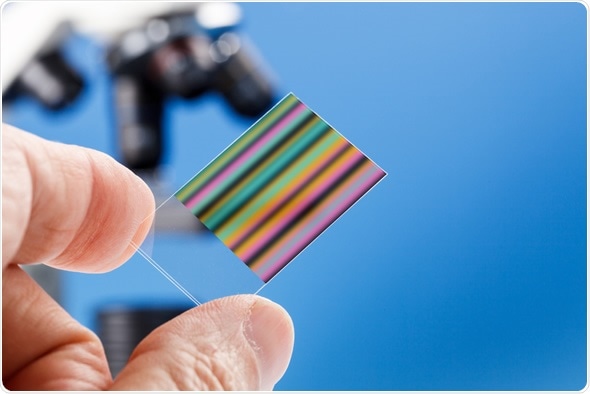Chromatography in Greek means to ‘write with colors.’ It is a versatile separation technique developed in 1903 by Mikhail Tswett, a Russian botanist. He separated colorful plant pigments using a column of calcium carbonate. Ever since its discovery, chromatography has evolved as a powerful tool in the lab for the separation and identification of different compounds in a mixture.

Chromatography genetic fingerprinting - Image Copyright: science photo / Shutterstock
The Principle of Chromatography
Chromatography exploits the difference in polarity of different molecules in a mixture. In this technique, a liquid acts as a mobile phase and it sweeps over a bed of particles called the stationary phase. A sample solution containing the mixture to be separated is introduced into the mobile phase which moves through the stable stationary phase. The components in the mixture are separated based on their relative affinity to the two phases. Molecules having a greater affinity to the stationary phase travel slower than the ones with lesser affinity. The separated molecules are then compared to known standards and identified.
Tosoh Basics - What is chromatography?
The Advantages of Chromatography
- Precise separation, analyses, and purification is possible using chromatography.
- It requires very low sample volumes.
- It works on a wide range of samples including drugs, food particles, plastics, pesticides, air and water samples, and tissue extracts.
- Mixture components separated by chromatography can be collected individually.
- It can be used to separate highly complex mixtures.
The Types of Chromatography
Chromatography has evolved over the years based on the varying needs for molecular separation. Today several types of chromatography are being used for different purposes in labs across the world. Some important types are briefly discussed below:
Paper Chromatography – Paper soaked in a liquid is used as a stationary phase while a liquid solvent acts as the mobile phase. Separated components appear as spots on the paper once it is dried.
Liquid Chromatography – This technique uses silica and alumina as the stationary phase and organic solvents as the mobile phase.
Thin layer chromatography – Here, a plastic or glass sheet is coated with a thin layer of adsorbent such as alumina (Al2O3) or silica (SiO2). Components are separated based on their affinity to the adsorbent and appear as individual spots on the sheet after chromatographic separation.
Column chromatography - Column chromatography is similar to thin layer chromatography by using the same stationary and mobile phase. The difference here is that both phases are contained within a vertical glass column and the process of separation is time consuming.
Gas chromatography (GC) - In GC, an inert gas (Helium, Nitrogen, Argon) is used as a mobile phase and a solid or liquid usually made up of silicon polymers is the stationary phase. The sample mixture is introduced to the column lined with the stationary phase and is selectively adsorbed. The separated molecules are identified using a detector as they leave the column.
High performance liquid chromatography (HPLC) – HPLC is an advanced form of column chromatography. In HPLC, a sample mixture is introduced into the mobile phase (often a solvent) and this is then pumped into a tightly-packed analytical column at high pressure for rapid separation of the sample molecules. This separation relies on the affinity of the molecules for both the mobile phase and particles coating the column (the stationary phase). It is also called high pressure liquid chromatography.Affinity chromatography – This method is used to separate biochemical mixtures on the basis of the specific affinity between different cognate components such as enzyme and substrate, antigen and antibody, or receptor and ligand.
Ion-exchange chromatography – This is carried out to separate ions and polar molecules on the basis of their affinity to an ion exchanger. It helps in the separation of charged molecules such as proteins, amino acids, and nucleotides. Here, the mobile phase is often a conductive solution (determined by salt concentration). The adsorption of the sample molecules to an oppositely charged solid support is driven by specific ionic properties e.g. the number and location of the charges on the molecule.
The separation involves varying conditions such as ionic strength and pH so that solute molecules are released from the column in the order of their strengths of binding, the most weakly bound substances being eluted first.
The Applications of Chromatography
The important applications of chromatography in various industries are listed below:
- To monitor air quality and to test drinking water
- In detection of drugs in urine and other body fluids
- Used in chemical fingerprinting and species identification
- In the pharmaceutical industry:
- to purify materials and analyze chemical compounds for trace contaminants
- to separate chiral compounds
- For quality control in the food industry:
- separation and analysis of additives, preservatives, vitamins, and proteins
- to detect toxins and contaminants in food
References
Further Reading